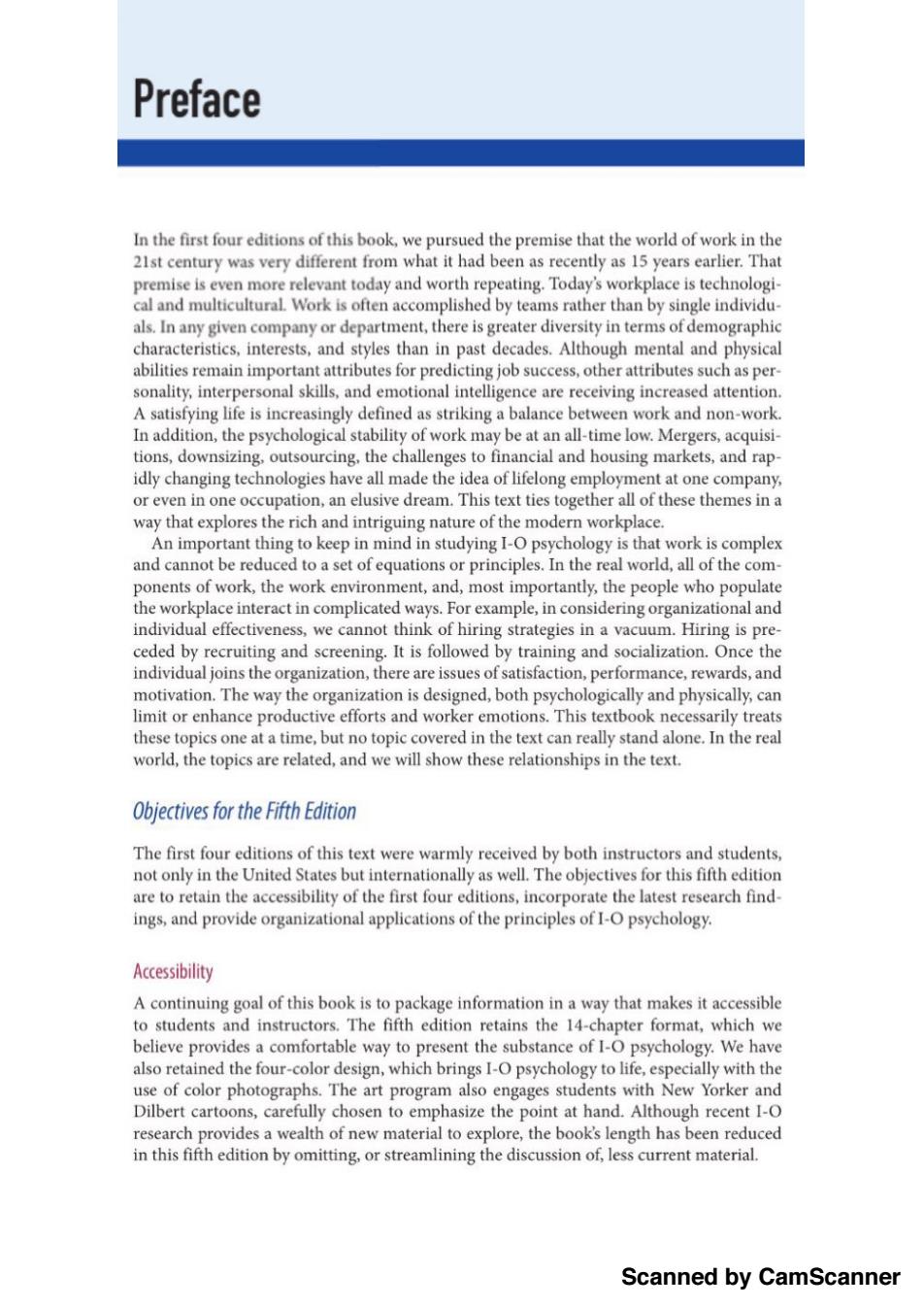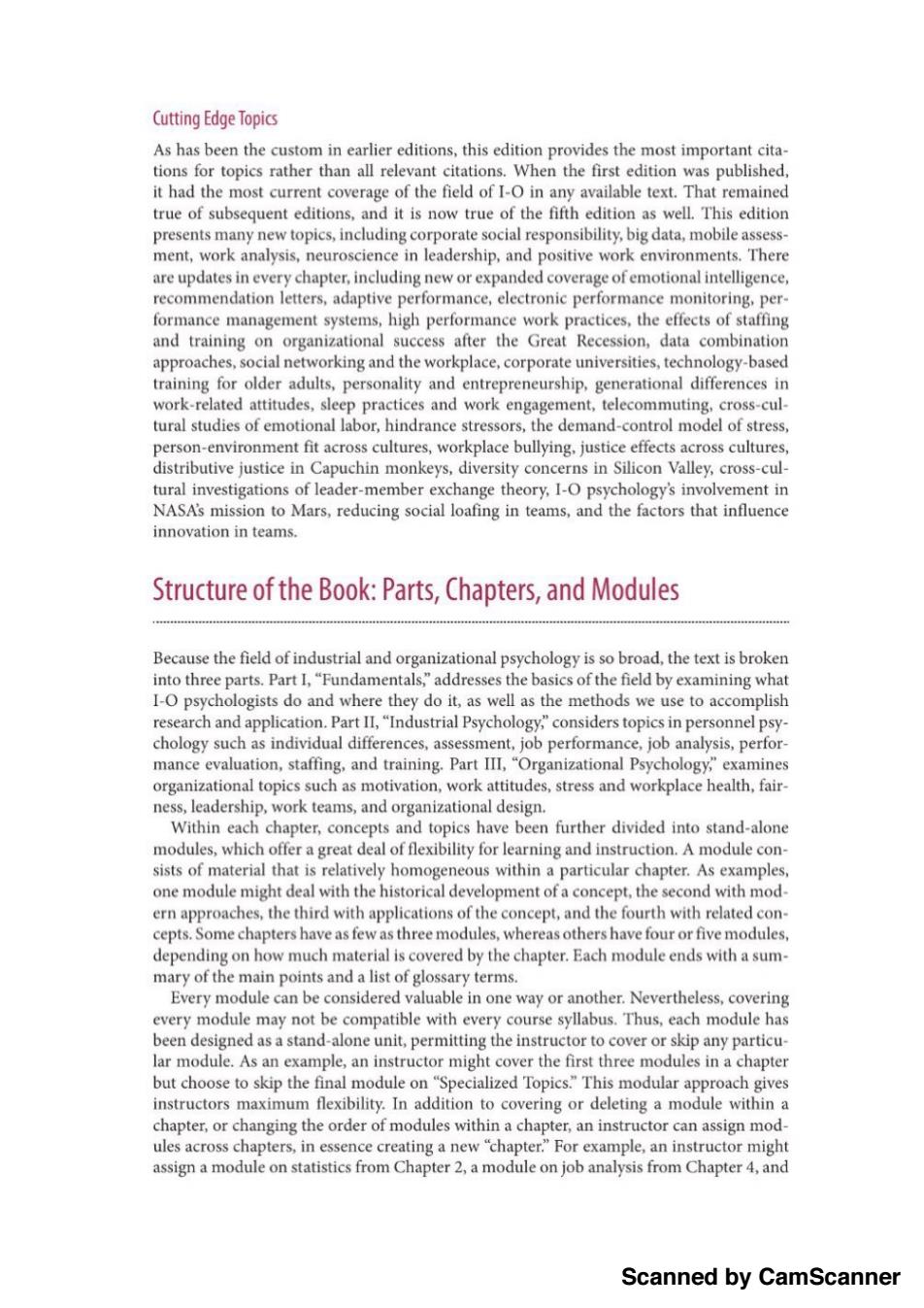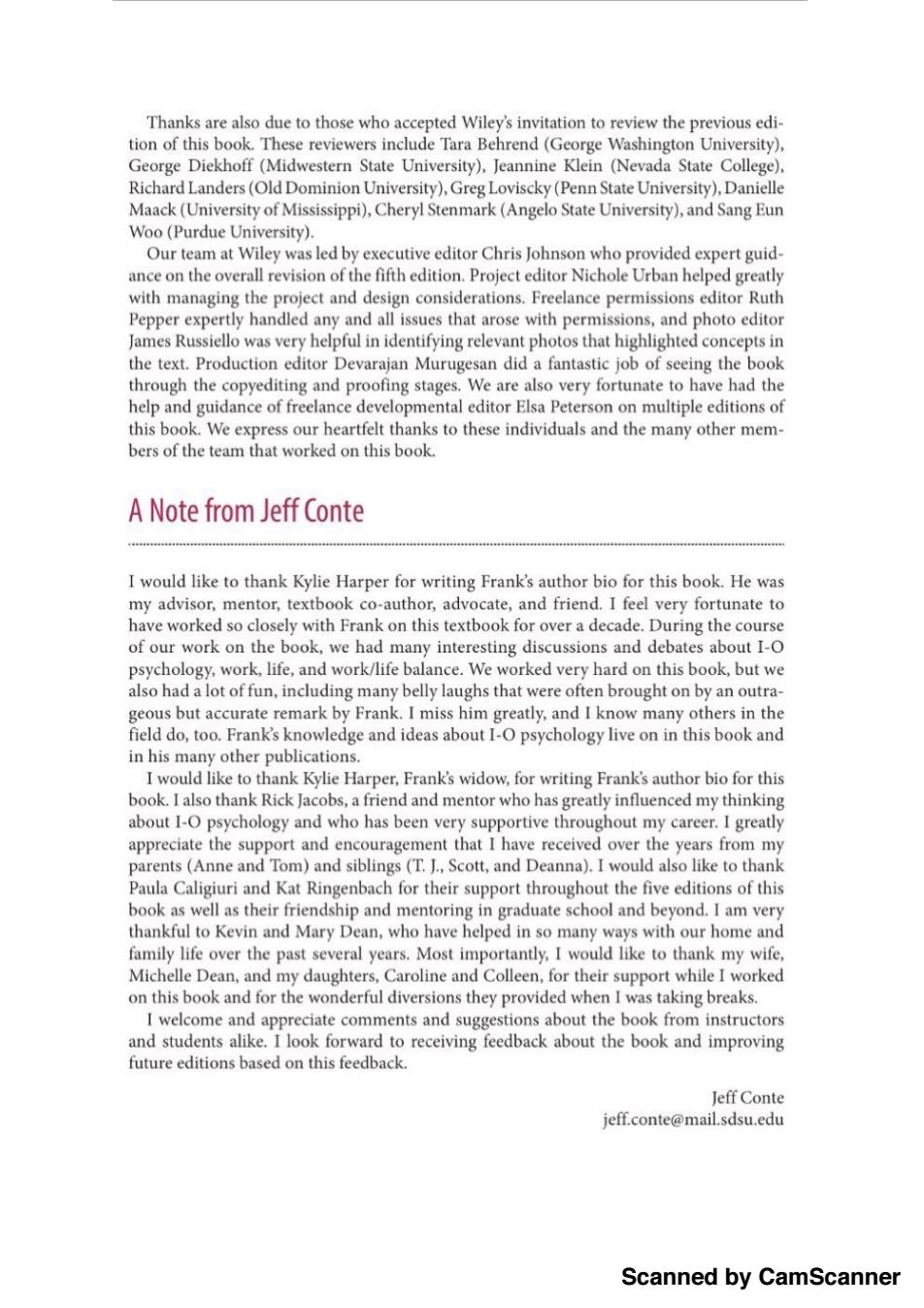
Preface In the first four editions of this book,we pursued the premise that the world of work in the 21st century was very different from what it had been as recently as 15 years earlier.That premise is even more relevant today and worth repeating.Today's workplace is technologi- cal and multicultural.Work is often accomplished by teams rather than by single individu- als.In any given company or department,there is greater diversity in terms of demographic characteristics,interests,and styles than in past decades.Although mental and physical abilities remain important attributes for predicting job success,other attributes such as per- sonality,interpersonal skills,and emotional intelligence are receiving increased attention. A satisfying life is increasingly defined as striking a balance between work and non-work. In addition,the psychological stability of work may be at an all-time low.Mergers,acquisi- tions,downsizing,outsourcing,the challenges to financial and housing markets,and rap- idly changing technologies have all made the idea of lifelong employment at one company, or even in one occupation,an elusive dream.This text ties together all of these themes in a way that explores the rich and intriguing nature of the modern workplace. An important thing to keep in mind in studying I-O psychology is that work is complex and cannot be reduced to a set of equations or principles.In the real world,all of the com- ponents of work,the work environment,and,most importantly,the people who populate the workplace interact in complicated ways.For example,in considering organizational and individual effectiveness,we cannot think of hiring strategies in a vacuum.Hiring is pre- ceded by recruiting and screening.It is followed by training and socialization.Once the individual joins the organization,there are issues of satisfaction,performance,rewards,and motivation.The way the organization is designed,both psychologically and physically,can limit or enhance productive efforts and worker emotions.This textbook necessarily treats these topics one at a time,but no topic covered in the text can really stand alone.In the real world,the topics are related,and we will show these relationships in the text. Objectives for the Fifth Edition The first four editions of this text were warmly received by both instructors and students, not only in the United States but internationally as well.The objectives for this fifth edition are to retain the accessibility of the first four editions,incorporate the latest research find- ings,and provide organizational applications of the principles of I-O psychology. Accessibility A continuing goal of this book is to package information in a way that makes it accessible to students and instructors.The fifth edition retains the 14-chapter format,which we believe provides a comfortable way to present the substance of I-O psychology.We have also retained the four-color design,which brings I-O psychology to life,especially with the use of color photographs.The art program also engages students with New Yorker and Dilbert cartoons,carefully chosen to emphasize the point at hand.Although recent I-O research provides a wealth of new material to explore,the book's length has been reduced in this fifth edition by omitting,or streamlining the discussion of,less current material. Scanned by CamScanner
Scanned by CamScanner

Cutting Edge Topics As has been the custom in earlier editions,this edition provides the most important cita- tions for topics rather than all relevant citations.When the first edition was published it had the most current coverage of the field of I-O in any available text.That remained true of subsequent editions,and it is now true of the fifth edition as well.This edition presents many new topics,including corporate social responsibility,big data,mobile assess- ment,work analysis,neuroscience in leadership,and positive work environments.There are updates in every chapter,including new or expanded coverage of emotional intelligence, recommendation letters,adaptive performance,electronic performance monitoring,per- formance management systems,high performance work practices,the effects of staffing and training on organizational success after the Great Recession,data combination approaches,social networking and the workplace,corporate universities,technology-based training for older adults,personality and entrepreneurship,generational differences in work-related attitudes,sleep practices and work engagement,telecommuting,cross-cul- tural studies of emotional labor,hindrance stressors,the demand-control model of stress, person-environment fit across cultures,workplace bullying,justice effects across cultures, distributive justice in Capuchin monkeys,diversity concerns in Silicon Valley,cross-cul- tural investigations of leader-member exchange theory,1-O psychology's involvement in NASA's mission to Mars,reducing social loafing in teams,and the factors that influence innovation in teams. Structure of the Book:Parts,Chapters,and Modules Because the field of industrial and organizational psychology is so broad,the text is broken into three parts.Part I,"Fundamentals,"addresses the basics of the field by examining what I-O psychologists do and where they do it,as well as the methods we use to accomplish research and application.Part II,"Industrial Psychology,"considers topics in personnel psy- chology such as individual differences,assessment,job performance,job analysis,perfor- mance evaluation,staffing,and training.Part III,"Organizational Psychology,"examines organizational topics such as motivation,work attitudes,stress and workplace health,fair- ness,leadership,work teams,and organizational design. Within each chapter,concepts and topics have been further divided into stand-alone modules,which offer a great deal of flexibility for learning and instruction.A module con- sists of material that is relatively homogeneous within a particular chapter.As examples, one module might deal with the historical development of a concept,the second with mod- ern approaches,the third with applications of the concept,and the fourth with related con- cepts.Some chapters have as few as three modules,whereas others have four or five modules. depending on how much material is covered by the chapter.Each module ends with a sum- mary of the main points and a list of glossary terms. Every module can be considered valuable in one way or another.Nevertheless,covering every module may not be compatible with every course syllabus.Thus,each module has been designed as a stand-alone unit,permitting the instructor to cover or skip any particu- lar module.As an example,an instructor might cover the first three modules in a chapter but choose to skip the final module on"Specialized Topics."This modular approach gives instructors maximum flexibility.In addition to covering or deleting a module within a chapter,or changing the order of modules within a chapter,an instructor can assign mod- ules across chapters,in essence creating a new"chapter."For example,an instructor might assign a module on statistics from Chapter 2,a module on job analysis from Chapter 4,and Scanned by CamScanner
Scanned by CamScanner

a module on assessment from Chapter 3 to create a"validity"chapter.Although we believe that the modules within a chapter complement one another,instructors might prefer a dif- ferent order of modules. As you read through the book,you will notice that a given topic may appear in several different chapters.That is not a mistake or oversight.The fact is that some topics have relevance in many different chapters,and to mention them only once presents too sim- plistic a view of work dynamics.As an example,competencies are higher-order forms of ability,personality,interests,and attitudes.Competency modeling is an enhanced form of job analysis.Competencies can be learned,and there are both leader competencies and team competencies.This means that you will see the term "competency"in several chapters.Even though you will see the term often,it will be treated from a different perspective each time it appears.You will see similar treatments of issues related to work/family balance.This balance is important in the attitudes that an individual holds toward work and organizations.Balance is also important in addressing work stress and work design.So"balance"will appear in multiple chapters.We hope that this method of treatment provides a richer understanding of the effects of work on people and people on work. Supplements for Students and Instructors Work in the 21st Century offers several supplements to enhance learning processes and teaching activities.The supplements are available on the text's website:www.wiley.com/col- lege/landy Website for Instructors The instructor side of the Work in the 21st Century website contains all the material instructors need for course design,and it is a convenient way to access the Instructor's Manual,Test Bank,PowerPoint slides,Internet resources for each chapter,and supplemen- tary material. Instructor's Manual The Instructor's Manual includes learning objectives,chapter outlines,glossary terms,and suggestions for class discussions and activities. PowerPoint Slides This package of 30-50 slides per chapter includes lecture outlines in addition to figures and tables from the text.The slides can be used as is or customized to match your course design and goals. Test Bank This array of 30-50 multiple-choice items per chapter covers all the important concepts with factual and applied questions as well as questions of a more conceptual nature to facili- tate critical thinking. Scanned by CamScanner
Scanned by CamScanner

Website for Students The student side of the Work in the 21st Century website at www.wiley.com/college/landy contains the Student Study Guide and Workbook as well as links to a variety of Internet resources for further exploration. Student Study Guide and Workbook Available on the student side of the website,this study guide is a valuable tool for maximiz- ing students'understanding of material and preparation for exams.The guide was devel- oped in close conjunction with the textbook and facilitates the instructor's course design by providing students with the same learning objectives,chapter outlines,and glossary terms as the Instructor's Manual.In addition,it includes practice exam questions and exercises for each chapter.The workbook exercises,based on organizational issues that I-O psycholo- gists are often asked to study and resolve,promote active learning,critical thinking,and practical applications of the ideas and concepts discussed in class and in the textbook Acknowledgments Throughout our work on all five editions of this book,many colleagues have been kind enough to send us their work in particular areas,provide helpful suggestions for particular topics,or otherwise provide support for work on this book.These colleagues include Patti Ambrose,Bruce Avolio,Zeynep Aycan,Talya Bauer,Laura Borgogni,Wally Borman,Andre Bussing,Dan Cable,Paula Caligiuri,Gian Vittorio Caprara,Gary Carter,Wayne Cascio, Diane Catanzaro,Donna Chrobot-Mason,Jan Cleveland,Cary Cooper,Filip de Fruyt, Peter Dorfman,Fritz Drasgow,Dov Eden,Miriam Erez,Jim Farr,Harold Goldstein,the late Irv Goldstein,Randy Gordon,Mark Griffin,Art Gutman,the late Richard Hackman,Lee Hakel,Kylie Harper,Michael Harris,Dave Harrison,Chris Hartel,Beryl Hesketh,Scott Highhouse,David Hofmann,Geert Hofstede,Ann Howard,Susan Jackson,Dick Jeanneret, Ruth Kanfer,Jerry Kehoe,Rich Klimoski,Laura Koppes,Steve Kozlowski,Filip Lievens, David Lubinski,Dianne Maranto,John Mathieu,Jack Mayer,Terry Mitchell,Susan Mohammed,David Morris,Barb Nett,Nigel Nicholson,Erik Olson,Lauren Ostroski, Rupande Padaki,Sharon Parker,Elizabeth Poposki,Bob Pritchard,Anat Rafaeli,Doug Reynolds,Tracey Rizzuto,Ivan Roberston,Robert Roe,Angie Rosenbaum,Paul Sackett, Gina Sadler,Wilmar Schaufeli,Gary Schmidt,Heinz Schuler,Graham Seager,Norbert Semmer,Jacob Seybert,Peter Smith,Karen Smola,Dirk Steiner,Robert Tett,Paul Thayer, Kecia Thomas,Susan Vanhemmel,Peter Warr,Dieter Zapf,and Shelly Zedeck.In addition, several colleagues went well out of their way to help us by providing reviews of draft mate- rial,suggestions for additional research,and contacts with researchers whose excellent work might have gone unnoticed.These colleagues include Robert Baron,Dave Bartram,Stuart Carr,David Day,Michelle Dean,Michael Frese,the late Bob Guion,Rick Jacobs,Tim Judge, Kurt Kraiger,David Kravitz,Kevin Murphy,Neal Schmitt,Ben Schneider,Rolf van Dick, Bernie Weiner,Howard Weiss,and Bob Wood. At San Diego State University (SDSU),many colleagues within and outside the psychol- ogy department helped to provide a supportive environment in which to work.In particu- lar,Mark Ehrhart,Kate Hattrup,Lisa Kath,Jorg Matt,Scott Roesch,and Emilio Ulloa represent a very supportive group of applied psychologists at SDSU. Scanned by CamScanner
Scanned by CamScanner

Thanks are also due to those who accepted Wiley's invitation to review the previous edi- tion of this book.These reviewers include Tara Behrend(George Washington University), George Diekhoff(Midwestern State University),Jeannine Klein (Nevada State College), Richard Landers(Old Dominion University),Greg Loviscky(Penn State University),Danielle Maack(University of Mississippi),Cheryl Stenmark(Angelo State University),and Sang Eun Woo (Purdue University). Our team at Wiley was led by executive editor Chris Johnson who provided expert guid- ance on the overall revision of the fifth edition.Project editor Nichole Urban helped greatly with managing the project and design considerations.Freelance permissions editor Ruth Pepper expertly handled any and all issues that arose with permissions,and photo editor James Russiello was very helpful in identifying relevant photos that highlighted concepts in the text.Production editor Devarajan Murugesan did a fantastic job of seeing the book through the copyediting and proofing stages.We are also very fortunate to have had the help and guidance of freelance developmental editor Elsa Peterson on multiple editions of this book.We express our heartfelt thanks to these individuals and the many other mem- bers of the team that worked on this book. A Note from Jeff Conte I would like to thank Kylie Harper for writing Frank's author bio for this book.He was my advisor,mentor,textbook co-author,advocate,and friend.I feel very fortunate to have worked so closely with Frank on this textbook for over a decade.During the course of our work on the book,we had many interesting discussions and debates about I-O psychology,work,life,and work/life balance.We worked very hard on this book,but we also had a lot of fun,including many belly laughs that were often brought on by an outra- geous but accurate remark by Frank.I miss him greatly,and I know many others in the field do,too.Frank's knowledge and ideas about I-O psychology live on in this book and in his many other publications. I would like to thank Kylie Harper,Frank's widow,for writing Frank's author bio for this book.I also thank Rick Jacobs,a friend and mentor who has greatly influenced my thinking about I-O psychology and who has been very supportive throughout my career.I greatly appreciate the support and encouragement that I have received over the years from my parents (Anne and Tom)and siblings (T.J.,Scott,and Deanna).I would also like to thank Paula Caligiuri and Kat Ringenbach for their support throughout the five editions of this book as well as their friendship and mentoring in graduate school and beyond.I am very thankful to Kevin and Mary Dean,who have helped in so many ways with our home and family life over the past several years.Most importantly,I would like to thank my wife, Michelle Dean,and my daughters,Caroline and Colleen,for their support while I worked on this book and for the wonderful diversions they provided when I was taking breaks. I welcome and appreciate comments and suggestions about the book from instructors and students alike.I look forward to receiving feedback about the book and improving future editions based on this feedback. Jeff Conte jeff.conte@mail.sdsu.edu Scanned by CamScanner
Scanned by CamScanner